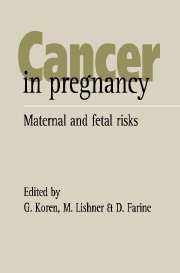Book contents
- Frontmatter
- Contents
- Preface
- List of contributors
- Part I Introduction
- 1 Cancer in pregnancy: identification of unanswered questions on maternal and fetal risks
- 2 The pregnant with malignant disease: maternal–fetal conflict
- 3 Changes in drug disposition during pregnancy and their clinical implications
- 4 The role of the placenta in the biotransformation of carcinogenic compounds
- 5 Antepartum fetal monitoring in the oncologic patient
- 6 The Toronto Study Group: methodological notes
- 7 Motherisk: the process of counselling in reproductive toxicology
- Part II Specific tumors during pregnancy
- Part III Fetal effects of cancer and its treatment
- Index
4 - The role of the placenta in the biotransformation of carcinogenic compounds
from Part I - Introduction
Published online by Cambridge University Press: 06 July 2010
- Frontmatter
- Contents
- Preface
- List of contributors
- Part I Introduction
- 1 Cancer in pregnancy: identification of unanswered questions on maternal and fetal risks
- 2 The pregnant with malignant disease: maternal–fetal conflict
- 3 Changes in drug disposition during pregnancy and their clinical implications
- 4 The role of the placenta in the biotransformation of carcinogenic compounds
- 5 Antepartum fetal monitoring in the oncologic patient
- 6 The Toronto Study Group: methodological notes
- 7 Motherisk: the process of counselling in reproductive toxicology
- Part II Specific tumors during pregnancy
- Part III Fetal effects of cancer and its treatment
- Index
Summary
Introduction
In this chapter we shall discuss the metabolic role of the placenta in activating or deactivating molecules which may be carcinogenic. We have recently described the metabolism of two primary arylamine substrates by acetyl coenzyme A-dependent arylamine TV-acetyltransferase (NAT) in human placenta. Another group of substrates for the NAT enzyme are the carcinogenic arylamines such as benzidine, β-naphthylamine and 4-aminobiphenyl. These compounds are generated industrially in the manufacture of dyestuffs, pesticides and plastics. In addition, these chemical entities may be found in the environment as products of fuel combustion and in cigarette smoke at concentrations for which there is evidence of carcinogenicity in human (1 to 22 ng per cigarette in mainstream smoke. Highly mutagenic aromatic amines have also been identified in protein-containing foods as products of the cooking process. These are of particular toxicologic interest since up to 35% of cancer deaths are believed to be linked to diet.
The association between cancer and exposure to aromatic amines was first identified in the late 1800s when cancer of the urinary bladder was linked to exposure to compounds used in the manufacture of aniline dyes. However, the first link between an individual aromatic amine entity and cancer was not made until 1938 when -naphthylamine was shown to induce urinary bladder cancer in dogs. Epidemiologic studies have now definitely linked three aromatic amine compounds (benzidine, β-naphthylamine, 4-aminobiphenyl) to cancer in humans.
- Type
- Chapter
- Information
- Cancer in PregnancyMaternal and Fetal Risks, pp. 38 - 52Publisher: Cambridge University PressPrint publication year: 1996

